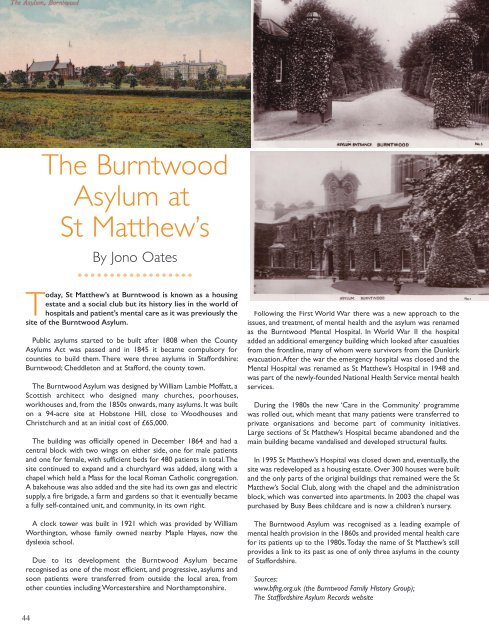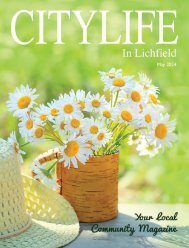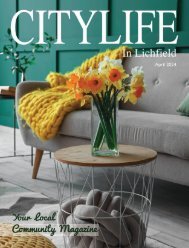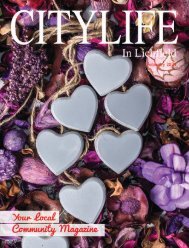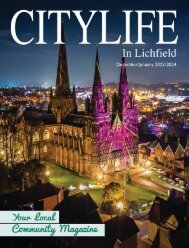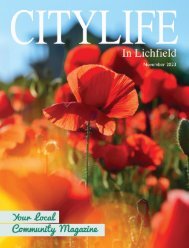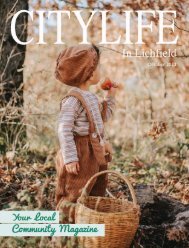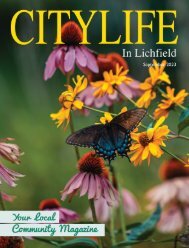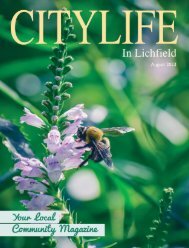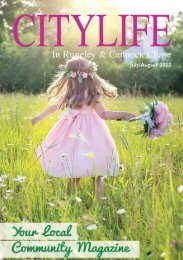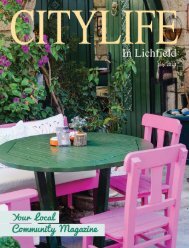Citylife in Lichfield July and August 2020
Brighter Days Ahead! Our combined July and August edition will take you all the way through the rest of summer in lovely Lichfield and is packed with our usual mix of features, recipes, articles, local news, history features, competitions and much, much more!
Brighter Days Ahead! Our combined July and August edition will take you all the way through the rest of summer in lovely Lichfield and is packed with our usual mix of features, recipes, articles, local news, history features, competitions and much, much more!
You also want an ePaper? Increase the reach of your titles
YUMPU automatically turns print PDFs into web optimized ePapers that Google loves.
The Burntwood<br />
Asylum at<br />
St Matthew’s<br />
By Jono Oates<br />
..................<br />
Today, St Matthew’s at Burntwood is known as a hous<strong>in</strong>g<br />
estate <strong>and</strong> a social club but its history lies <strong>in</strong> the world of<br />
hospitals <strong>and</strong> patient’s mental care as it was previously the<br />
site of the Burntwood Asylum.<br />
Public asylums started to be built after 1808 when the County<br />
Asylums Act was passed <strong>and</strong> <strong>in</strong> 1845 it became compulsory for<br />
counties to build them. There were three asylums <strong>in</strong> Staffordshire:<br />
Burntwood; Cheddleton <strong>and</strong> at Stafford, the county town.<br />
The Burntwood Asylum was designed by William Lambie Moffatt, a<br />
Scottish architect who designed many churches, poorhouses,<br />
workhouses <strong>and</strong>, from the 1850s onwards, many asylums. It was built<br />
on a 94-acre site at Hobstone Hill, close to Woodhouses <strong>and</strong><br />
Christchurch <strong>and</strong> at an <strong>in</strong>itial cost of £65,000.<br />
The build<strong>in</strong>g was officially opened <strong>in</strong> December 1864 <strong>and</strong> had a<br />
central block with two w<strong>in</strong>gs on either side, one for male patients<br />
<strong>and</strong> one for female, with sufficient beds for 480 patients <strong>in</strong> total. The<br />
site cont<strong>in</strong>ued to exp<strong>and</strong> <strong>and</strong> a churchyard was added, along with a<br />
chapel which held a Mass for the local Roman Catholic congregation.<br />
A bakehouse was also added <strong>and</strong> the site had its own gas <strong>and</strong> electric<br />
supply, a fire brigade, a farm <strong>and</strong> gardens so that it eventually became<br />
a fully self-conta<strong>in</strong>ed unit, <strong>and</strong> community, <strong>in</strong> its own right.<br />
A clock tower was built <strong>in</strong> 1921 which was provided by William<br />
Worth<strong>in</strong>gton, whose family owned nearby Maple Hayes, now the<br />
dyslexia school.<br />
Due to its development the Burntwood Asylum became<br />
recognised as one of the most efficient, <strong>and</strong> progressive, asylums <strong>and</strong><br />
soon patients were transferred from outside the local area, from<br />
other counties <strong>in</strong>clud<strong>in</strong>g Worcestershire <strong>and</strong> Northamptonshire.<br />
Follow<strong>in</strong>g the First World War there was a new approach to the<br />
issues, <strong>and</strong> treatment, of mental health <strong>and</strong> the asylum was renamed<br />
as the Burntwood Mental Hospital. In World War II the hospital<br />
added an additional emergency build<strong>in</strong>g which looked after casualties<br />
from the frontl<strong>in</strong>e, many of whom were survivors from the Dunkirk<br />
evacuation. After the war the emergency hospital was closed <strong>and</strong> the<br />
Mental Hospital was renamed as St Matthew’s Hospital <strong>in</strong> 1948 <strong>and</strong><br />
was part of the newly-founded National Health Service mental health<br />
services.<br />
Dur<strong>in</strong>g the 1980s the new ‘Care <strong>in</strong> the Community’ programme<br />
was rolled out, which meant that many patients were transferred to<br />
private organisations <strong>and</strong> become part of community <strong>in</strong>itiatives.<br />
Large sections of St Matthew’s Hospital became ab<strong>and</strong>oned <strong>and</strong> the<br />
ma<strong>in</strong> build<strong>in</strong>g became v<strong>and</strong>alised <strong>and</strong> developed structural faults.<br />
In 1995 St Matthew’s Hospital was closed down <strong>and</strong>, eventually, the<br />
site was redeveloped as a hous<strong>in</strong>g estate. Over 300 houses were built<br />
<strong>and</strong> the only parts of the orig<strong>in</strong>al build<strong>in</strong>gs that rema<strong>in</strong>ed were the St<br />
Matthew’s Social Club, along with the chapel <strong>and</strong> the adm<strong>in</strong>istration<br />
block, which was converted <strong>in</strong>to apartments. In 2003 the chapel was<br />
purchased by Busy Bees childcare <strong>and</strong> is now a children’s nursery.<br />
The Burntwood Asylum was recognised as a lead<strong>in</strong>g example of<br />
mental health provision <strong>in</strong> the 1860s <strong>and</strong> provided mental health care<br />
for its patients up to the 1980s. Today the name of St Matthew’s still<br />
provides a l<strong>in</strong>k to its past as one of only three asylums <strong>in</strong> the county<br />
of Staffordshire.<br />
Sources:<br />
www.bfhg.org.uk (the Burntwood Family History Group);<br />
The Staffordshire Asylum Records website<br />
44


